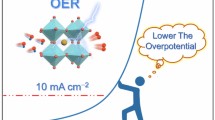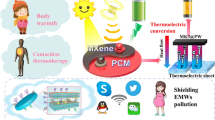Abstract
Various graphene oxide (GO)–pentaerythritol tetranitrate (PETN) micro-composites were prepared in this study to investigate the influence of nanomaterials on the stability of PETN. Differential scanning calorimetry analysis showed that PETN microcrystals become more stable after doping with GO. Additionally, thermogravimetric analysis indicated that sublimation rates and vapor pressures of various GO–PETN micro-composites were significantly reduced compared to pure PETN microcrystals. Scanning electron microscopy images indicated that PETN microcrystals were at least partially covered with GO, which may explain the increased thermal stability and reduced sublimation rate.



Similar content being viewed by others
Notes
This work has been partly published in 42nd North American Thermal Analysis Society (NATAS) conference.
References
Zhang X, Weeks BL. Improved stability and reduced sublimation rate of pentaerythritol tetranitrate through doping graphene. In: 42nd Annual Conference of NATAS. Santa Fe, New Mexico, September 15–17th, 2014.
Bushuyev OS, Brown P, Maiti A, Gee RH, Peterson GR, Weeks BL, Hope-Weeks LJ. Ionic polymers as a new structural motif for high-energy-density materials. J Am Chem Soc. 2012;134:1422–5.
Dlott DD. Thinking big (and small) about energetic materials. Mater Sci Technol. 2006;22:463–73.
Rossi C, Zhang K, Estève D, Alphonse P, Tailhades P, Vahlas C. Nanoenergetic materials for MEMS: a review. J Microelectromech Syst. 2007;16:919–31.
Zhang X, Hikal WM, Zhang Y, Bhattacharia SK, Li L, Panditrao S, Wang S, Weeks BL. Direct laser initiation and improved thermal stability of nitrocellulose/graphene oxide nanocomposites. Appl Phys Lett. 2013;102:141905.
McGrane SD, Grieco A, Ramos KJ, Hooks DE, Moore DS. Femtosecond micromachining of internal voids in high explosive crystals for studies of hot spot initiation. J Appl Phys. 2009;105:073505.
Qiu H, Stepanov V, Di Stasio AR, Chou T, Lee WY. RDX-based nanocomposite microparticles for significantly reduced shock sensitivity. J Hazard Mater. 2011;185:489–93.
Sivabalan R, Gore GM, Nair UR, Saikia A, Venugopalan S, Gandhe BR. Study on ultrasound assisted precipitation of CL-20 and its effect on morphology and sensitivity. J Hazard Mater. 2007;139:199–203.
Yi J, Zhao F, Hong W, Xu S, Hu R, Chen Z, Zhang L. Effects of Bi-NTO complex on thermal behaviors, nonisothermal reaction kinetics and burning rates of NG/TEGDN/NC propellant. J Hazard Mater. 2010;176:257–61.
Zhang X, Weeks BL. Preparation of sub-micron nitrocellulose particles for improved combustion behavior. J Hazard Mater. 2014;268:224–8.
Chin A, Ellison DS, Poehlein SK, Ahn MK. Investigation of the decomposition mechanism and thermal stability of nitrocellulose/nitroglycerine based propellants by electron spin resonance. Propellants Explos Pyrotech. 2007;32:117–26.
Sovizi MR, Hajimirsadeghi SS, Naderizadeh B. Effect of particle size on thermal decomposition of nitrocellulose. J Hazard Mater. 2009;168:1134–9.
Zhang X, Zhang G, Liao YC, Weeks BL, Zhang Z. Embossing of organic thin films using a surfactant assisted lift-off technique. J Colloid Interface Sci. 2012;387:175–9.
Zhang G, Weeks BL, Zhang X. Crystal growth of organic energetic materials: pentaerythritol tetranitrate. Cent Eur J Eng. 2012;2:336–46.
Zhang X, Weeks BL. Tip induced crystallization lithography. J Am Chem Soc. 2014;136:1253–5.
Ingale SV, Wagh PB, Sastry PU, Patra AK, Tewari R, Singh IK, Phapale SB, Wasnik RD, Rao AS, Gupta SC. Nanocrystalline pentaerythritoltetranitrate using sol–gel process. Def Sci J. 2011;61:534–9.
Bhattacharia SK, Maiti A, Gee RH, Weeks BL. Sublimation properties of pentaerythritol tetranitrate single crystals doped with its homologs. Propellants Explos Pyrotech. 2012;37:563–8.
Mridha S, Weeks BL. Effect of Zn doping on the sublimation rate of pentaerythritol tetranitrate using atomic force microscopy. Scanning. 2009;31:181–7.
Pitchimani R, Zheng W, Simon SL, Hope-Weeks LJ, Burnham AK, Weeks BL. Thermodynamic analysis of pure and impurity doped pentaerythritol tetranitrate crystals grown at room temperature. J Therm Anal Calorim. 2007;89:475–8.
Bhattacharia SK, Maiti A, Gee RH, Nunley J, Weeks BL. Effect of homolog doping on surface morphology and mass-loss rates from PETN crystals: studies using atomic force microscope and thermogravimetric analysis. Propellants Explos Pyrotech. 2014;39:24–9.
Hikal WM, Bhattacharia SK, Weeks BL. Effect of porphyrin doping on thermodynamic parameters of pentaerythritol tetranitrate (PETN) single crystals. Propellants Explos Pyrotech. 2012;37:718–23.
Foltz MF. Aging of pentaerythritol tetranitrate (PETN). In: Report LLNL-TR-415057. Livermore: Lawrence Livermore National Laboratory; 2009.
Zhu Y, Murali S, Cai W, Li X, Suk JW, Potts JR, Ruoff RS. Graphene and graphene oxide: synthesis, properties, and applications. Adv Mater. 2010;22:3906–24.
Huang X, Qi X, Boey F, Zhang H. Graphene-based composites. Chem Soc Rev. 2012;41:666–86.
Allen MJ, Tung VC, Kaner RB. Honeycomb carbon: a review of graphene. Chem Rev. 2010;110:132–45.
Ramanathan T, Abdala AA, Stankovich S, Dikin DA, Herrera-Alonso M, Piner RD, Adamson DH, Schniepp HC, Chen X, Ruoff RS, Nguyen ST, Aksay IA, Prud’Homme RK, Brinson LC. Functionalized graphene sheets for polymer nanocomposites. Nat Nanotechnol. 2008;3:327–31.
Wan Y, Tang L, Gong L, Yan D, Li Y, Wu L, Jiang J, Lai G. Grafting of epoxy chains onto graphene oxide for epoxy composites with improved mechanical and thermal properties. Carbon. 2014;69:467–80.
Yuan B, Bao C, Song L, Hong N, Liew KM, Hu Y. Grafting of epoxy chains onto graphene oxide for epoxy composites with improved mechanical and thermal properties. Chem Eng J. 2014;237:411–20.
Li X, McKenna GB. Considering viscoelastic micromechanics for the reinforcement of graphene polymer nanocomposites. ACS Macro Lett. 2012;1:388–91.
Ozawa T. Kinetic analysis of derivative curves in thermal analysis. J Therm Anal. 1970;2:301–24.
Kissinger HE. Reaction kinetics in differential thermal analysis. Anal Chem. 1957;29:1702–6.
Smeu M, Zahid F, Ji W, Guo H, Jaidann M, Abou-Rachid H. Reaction kinetics in differential thermal analysis. J Phys Chem C. 2011;115:10985–9.
Langmuir I. The vapor pressure of metallic tungsten. Phys Rev. 1913;2:329–42.
Acknowledgements
The authors are grateful for support received from the Office of Naval Research (ONR) under Award Number N00014-11-1-0424 and the US Department of Homeland Security under Award Number 2008-ST-061-ED0001.
Author information
Authors and Affiliations
Corresponding authors
Rights and permissions
About this article
Cite this article
Zhang, X., Weeks, B.L. Improved thermal stability and reduced sublimation rate of pentaerythritol tetranitrate through doping graphene oxide. J Therm Anal Calorim 122, 1061–1067 (2015). https://doi.org/10.1007/s10973-015-5005-2
Received:
Accepted:
Published:
Issue Date:
DOI: https://doi.org/10.1007/s10973-015-5005-2




